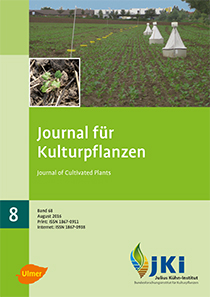Effects of biochar on dry matter production and competitive ability of <em>Rumex obtusifolius</em> L.
Keywords:
Pot experiment, grassland soil, nutrient requirement, interspecific competition, weed controlAbstract
Rumex obtusifolius L. (broad-leaved dock) is one of the most troublesome weeds in intensively managed grassland. This study investigated the potential of biochar (BC), produced from woody green waste residues, to support its control. For this purpose, a pot experiment was conducted out of doors in Austria. It was expected that R. obtusifolius could be controlled by reducing available N content in the soil. R. obtusifolius and two grass species, Lolium multiflorum and Dactylis glomerata, were grown from seeds in monocultures, respectively. Moreover, R. obtusifolius was grown in mixtures with L. multiflorum. Due to a pure BC addition to soil (3% by wt), the concentrations of N, S, Ca and Mg in the shoot biomass decreased relative to the control in all three species, suggesting a dilution effect. The K concentration, however, increased only in R. obtusifolius, indicating its high absorption capacity for K. In R. obtusifolius, K rather than N was the most growth-limiting nutrient element. The K level in soil appears to be important in controlling its distribution. To prevent Rumex infestation and/or to reduce existing infestations, a high soil K supply should be avoided. The average shoot dry weight of all three species was significantly higher when BC was applied (by 247%, 65% and 108%, in R. obtusifolius, L. multiflorum and D. glomerata, respectively), presumably because of a better K supply in soil. R. obtusifolius responded to interspecific competition with L. multiflorum by a density-dependent reduction of its shoot growth. BC did not decrease the competitive ability of Rumex in mixtures with Lolium. It is concluded that the addition of woody green waste BC to soil is no successful strategy for controlling R. obtusifolius in grassland. However, the results of this study can serve as a basis for preventive measures to Rumex control.
DOI: 10.5073/JfK.2016.08.03, https://doi.org/10.5073/JfK.2016.08.03
Published
Issue
Section
License
The content of the journal is licensed under the Creative Commons Attribution 4.0 License. Any user is free to share and adapt (remix, transform, build upon) the content as long as the original publication is attributed (authors, title, year, journal, issue, pages).
The copyright of the published work remains with the authors. The authors grant the Journal of Cultivated Plants, the Julius Kühn-Institut and the OpenAgrar repository the non-exclusive right to distribute and exploit the work.







